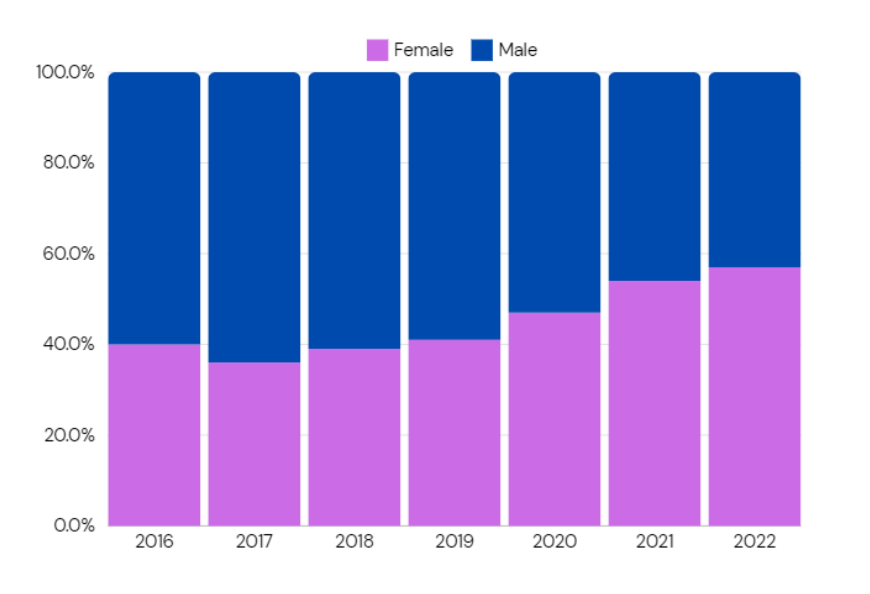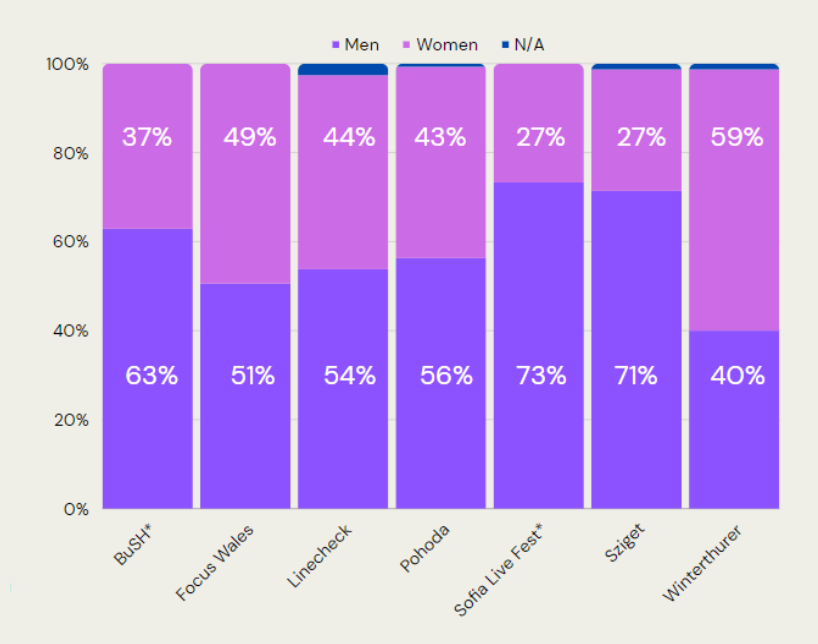Preliminary results
At the moment, two MA students have finished their research within the project. Here you can read their extensive public summary in which the students elaborate on their methodology and the theory they used.
Diversity at Roskilde and ESNS
Cultural Leadership student Dan Padure researched the gender distribution in the line-ups of showcase festivals Eurosonic Noorderslag (The Netherlands) and Roskilde (Denmark) over the period 2016-2022. He also looked at the representation of artists and groups with people of color.
Notable about Dan’s research is that the diversity policies of both showcase festivals are quite fruitious. In 2016 the majority of acts on the line-up were constituted only of male members (71% at Roskilde and 60% at ESNS), but since 2019 we see a shift towards a more 50/50 distribution. There was even a majority of acts that had either a gender-mixed or a fully female componence in the case of both of the festivals (60% at Roskilde and 57% at ESNS). Please note that the total number of male performers is still significantly higher in both cases as we speak, however, we see a strong decline in the number of all-male acts, in favor of more diverse acts.

According to Dan, the attention for the underrepresentation of non-white artists at festivals is growing, with Roskilde as a frontrunner. However, it is difficult to draw conclusions from the data, because the focus-areas and booking processes from both festivals are quite different from each other. Dan’s research does show us that, especially since 2020, the attention for a more diverse representation on stage is growing. The social and political discussion surrounding topics like mental health and systemic issues, as well as global resonant social movements such as "Black Lives Matter" that took place during the COVID-19 pandemic, might be amongst some of the main factors behind the acceleration of more representative line-ups.
Women heavily underrepresented at ESNS Exchange programme
Guest-student Juan Carlos Méndez Álvarez (Utrecht University) focussed his research on how the gender distribution in the line-ups of ESNS differed from the line-up that consisted of artists booked via the exchange programme (ESNS Exchange). In his research, Juan Carlos looked at artists who were booked 2 or more times by the ESNS Exchange programme between 2016 and 2019.
Juan Carlos’ research shows that, while ESNS has a 50/50 policy, an average of about 80% of the artists booked via the ESNS Exchange programme is male, whereas only 20% is female. For example, in 2019, 40% of the ESNS line-up was female, but this is not represented in the acts booked through the ESNS Exchange programme - 83% of these booked acts were male.

Big differences between showcase festivals and commercial festivals
Students Ricardo Robers, Eryn Kelly, Terezie Kvetonova, Aina Forteza Gomez, and Lea Gohdes examined the diversity of European partners of Eurosonic, such as Linecheck (Italy), Focus (Wales), and Sofia Live Fest (Bulgaria). It turns out that showcase festivals have a more balanced lineup compared to commercial festivals like Sziget (71% male). The students also noticed a significant difference between festivals from Western Europe and the former Eastern Bloc countries.

Festival Programmers: Do Male Bands Generate More Revenue?!
This discrepancy in representation raises questions, of course. How can there be such a big difference? Why is there such a significant difference in lineups between showcase festivals and commercial festivals like Sziget? The students spoke with four (male!) festival programmers about equality in the booking industry and the underlying motivations of programmers. The conversations revealed that programmers primarily focus on the professionalism and quality of the act, how popular the act is (for example, on social media), and whether the act fits the festival. At the same time, formal and informal networks also influence the booking process. These networks involve friendships and relationships between programmers and artists or their managers.
Although every interviewee mentioned having a female booker on their team, none of the organizations had a woman in a decision-making position. Only one festival employed a diversity officer. However, all the programmers emphasized the importance of discussing diversity in the workplace. Nevertheless, when financial incentives are at stake, programmers often opt for the safer choice: a big, often male act.
The students presented their results at the ESNS conference in January 2023 and January 2024 and also at the Music Matters event in March 2023.
Further research
ESNS has a lot of questions still waiting to be researched. Please email us if you are interested tawi rug.nl
-
What is the gender distribution within booking agencies? Are there disproportionate distributions and could these discrepancies explain the results of Juan Carlos’ research? What are the motivations of the bookers when they book the acts through the exchange programme of ESNS? Which choices do they make?
-
How diverse are other festivals in Europe, like Glastonbury, Reading Festival, Leeds Festival and Rock am Ring? Do we see the same patterns at these festivals?
-
Are there measuring methods based on diversity that are useful for ESNS? Can we standardize these methods to such an extent that we can compare multiple different events?
-
To what extent does this issue play a role in non-western European countries? Which issues do Eastern-European countries prioritize?
-
How do various festivals communicate their diversity policies? How can this be seen on their website and social media?
-
Living Lab: How diverse is the ESNS audience? Is the ESNS audience representative of the demographic characteristics of the wider European/Dutch audience?
-
How diverse are the Live Europe Music Venues (partnered clubs of ESNS)? How do they relate/compare to the ESNS programme?
| Last modified: | 30 August 2024 12.23 p.m. |
